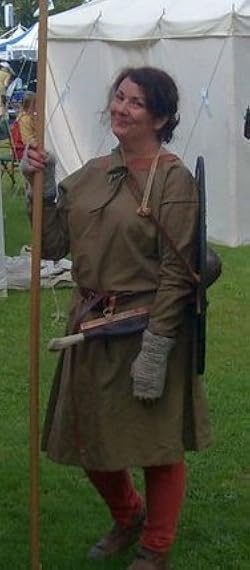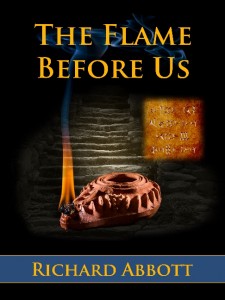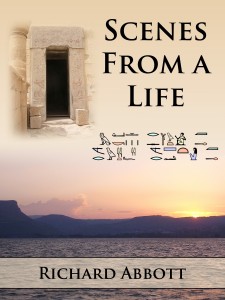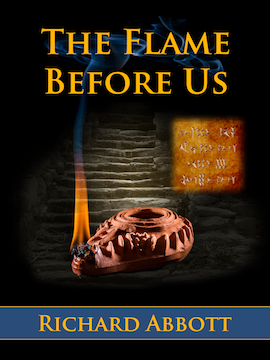Today I am delighted to welcome Paula Lofting to the blog, who has kindly answered a number of interview questions. Some while ago now I reviewed Sons of the Wolf, but as you read on you will find out lots of other things about Paula.

Q. Hi Paula, could you first give us a little introduction to yourself.
A. Yes, indeed, well my name is Paula Wilcox, but I use my maiden name of Lofting as my author’s name. I decided to use it because I didn’t want people thinking that the actress Paula Wilcox was writing my books lol, plus there is an old famous author called Hugh Lofting of Dr Dolittle fame and I am a distant cousin, so it seems appropriate to use it – *laughs.
I am a psychiatric nurse by day and in my spare time I love to write. I’m working on my second novel at the moment but time is at a premium, especially as I help run The Review blog and also re-enact Dark Age history. So finishing a book takes me a lot of time as I have to fit my writing into my daily life where I can.
Q. I first came across you via a copy of Sons of the Wolf. This was your debut novel, I believe. What first gave you the inspiration for writing this book?
A. There are a lot of factors that inspired that book. These are just some: a visit to an English Heritage re-enactment of the Battle of Hastings at Battle Abbey for one, the book 1066-The Year of the Conquest by David Howarth and a desire to know more about the Anglo Saxons and why Harold took the throne from the so-called rightful heir. I thought about writing about the story of Hastings from the point of view of the two protagonists, Harold and William, but that has been done a few times now, so I had this idea from reading David Howarth’s book. He shows the events of that year through the eyes of a village and its inhabitants. It was the major factor that spurred me on to write the story.
I found David Howarth’s little gem 1066 The Year Of The Conquest at a medieval fare. He tells the story of 1066 from the standpoint of a Sussex village. He chose Little Horsted, a tiny village near Uckfield, as it was his own home and describes the holding as it was in the Domesday Book. I already had the basis of a story that I wanted to write, I just needed a character. I had thought to invent my own village and my own thegn but here was Wulfhere, Thegn of Horstede, according to the Domesday Book, just waiting for me to find him.
A blood feud between Wulfhere and his neighbour Helghi, forms the basis of the story which also encapsulates the politics and historical events of the time, drawing on what primary sources are available. So it’s a mixture of facts and fiction, and because the sources for this time are scarce in their entirety, it is an author’s dream to fill in the gaps with plausible possibilities. The novel has a large cast which includes fictional and historical characters which I had fun playing around with. Don’t you just love torturing the bodies and minds of your characters?
Q. I gather you have participated in historical reconstruction events, a level of research that few of us have braved. Indeed, your Amazon author page photo shows you taking part in such an event. Can you tell us a little about that? Does it feed directly into your writing or indirectly? Which came first – the writing or the participation?
 A. Well, once I had decided I wanted to write this novel, I contacted Regia Anglorum (www.regia.org) after finding them on the internet and applied to join. I had always been interested in this kind of hobby but I had never been in a place where I felt confident enough or in the right time. It was the same with the writing. It had been a childhood dream to write a book, now I was at a time and place in my life where I was able to do both and because I wanted to write my story as authentically as possible, I thought it would be an enjoyable way to gain the knowledge needed to enhance my writing, for example, those little details you struggle with are often the simple things, like what they ate, how they made their food, how did a village community function, what did they wear and what did they NOT wear, and it is so important for this period I believe, that one gets it right.
A. Well, once I had decided I wanted to write this novel, I contacted Regia Anglorum (www.regia.org) after finding them on the internet and applied to join. I had always been interested in this kind of hobby but I had never been in a place where I felt confident enough or in the right time. It was the same with the writing. It had been a childhood dream to write a book, now I was at a time and place in my life where I was able to do both and because I wanted to write my story as authentically as possible, I thought it would be an enjoyable way to gain the knowledge needed to enhance my writing, for example, those little details you struggle with are often the simple things, like what they ate, how they made their food, how did a village community function, what did they wear and what did they NOT wear, and it is so important for this period I believe, that one gets it right.
I’m a bit of a stickler where clothing is concerned. It’s very annoying to read about women running around with their hair tumbling over their shoulders in public instead of wearing head coverings, or men wearing breeches instead of trousers or mantles instead of cloaks. I thought in the beginning that I probably would stick around Regia for as long as I needed to learn stuff but I enjoyed it so much, that I’ve stayed there ever since and am now in my 8th year of being a member. I am so grateful to the society for the stuff I’ve learned which I feel has given me the gift of insight into life in those days – it’s not a perfect tool, because there is still a lot of research that is being done at the moment and some things just have to be interpreted because there isn’t enough evidence. But long days standing around in wet wool under shelters that pour water on you because of the rain, or days sitting in the hot sun, getting smoke in your eyes and up your nose have been so worth it, because I can actually feel what I am writing, especially when I am doing battle scenes.
When I first joined I wondered what could re-enactment do for my writing, nowadays it’s more like what can my writing do for my re-enactment?
Q. Some authors prefer to specialise while others spread themselves between several periods. Which is it for you? Do you see yourself as firmly wedded to that particular place and time for writing?
A. That’s a really good question, because I have toyed with ideas. I can see myself writing about the Last Days of Roman Britain or just after. I’ve always loved that time – Arthur and Ambrosius have always intrigued me and I have some ideas scooting around in my head. I also long to write a story for Aethelflaed, Lady of the Mercians and am also interested in a 1st WW novel and a Victorian Gothic horror and a modern day psychological thriller. If I could ever find the time to write them it would be so cool!
Q. Many people will meet you online through the Facebook Review Group (https://www.facebook.com/groups/398549953570025/ or http://thereview2014.blogspot.co.uk/) and its associated links. Tell us a little about the group, your dreams for it, and how far along the road it has reached. What prompted you to put time and energy into this?
A. I just had this thought one day that I wanted a group where authors and readers could come together to celebrate books using the forum of reviews. I had been in a lot of groups where people posted their buy links several times a week, rarely interacted with each other, nor did they share each other’s stuff. It just seemed so impersonal and I just thought, I want people to have fun, to share each other’s stuff, to interact and have discussions and support each other. I wanted people to share the reviews that they believed enticed them to read a book, to share their favourite reviews that their readers had written about their book, or share reviews they’d written themselves for others. So I came up with this idea that I would start a facebook group where the aim was to create a forum where we could do all of those things and invited some friends to help me admin it. As time went by, we came up with a Do list as opposed to a Don’t list because we decided that to keep it spam free, we would need some boundaries, such as no posting buy links and that links to reviews should be posted and not just copied and pasted. We all became experts in posting permalinks form Amazon lol! Then we added two days a week to share blog posts and so we grew like that until we created our own blog which you have linked above, to review books. We also recruited a reading team and found some more admins.
My vision for the blog was for us to produce high quality reviews of high quality books and I had this principle that we would never post a bad review. We had some guidelines where the reader was supposed to stop reading a book if they didn’t like it, but it was really difficult for them to adhere to that but gradually we weeded out the teething problems and came up with an idea that in order to not have to give good reviews to sub standard books, we would have a submissions process so that the admins team could preview the books and if approved, we sent them out for reviewing to our reading team. Those that don’t make the grade are nicely and respectfully let down, and given a brief overview of what our findings are and they have the opportunity to resubmit if they make changes.
So, what we aim for now on The Review is more of a showcasing rather than a review. We like to be analytical and give examples of what it was about the book that we enjoyed so much. We share, tweet, promote and support the book for around a week or so and this really gets the book out there to a wide variety of readers. All we ask from the author in return is a copy to giveaway to a lucky winner. Some authors have been very generous and it is to their advantage as we get a lot more draws to the post if we have a giveaway attached than if we don’t.
But it all hasn’t ended there, because in January this year, we launched our Book of the Month awards for Independent and self published authors. This has been a real exciting extension of what we do on The Review and it has been so well received. As for what’s next for The Review – I have some ideas, however our main joy and our main aim is to support and help authors of any type, whether they are indie, self published or traditional.
Q. You must have built up some great friendships through The Review and related activities. How important do you think online connections are in comparison with real-world ones? Do you get different kinds of input from online friends as opposed to those close at hand? Do you entertain thoughts of actually meeting some of your online friends for real one day?
 A. I am very good friends with all of my admins, reviewers and members, however, I have met up with lovely Louise Rule who lives about an hour and a half’s drive from me, and Jayne Smith who lives nearby and there are loads of people I’d love to meet up with. The friends I have that have been in my life before I started writing and joined the literary world are not really booky people, well not in the same sense and not to the degree that I am involved. However, I am so lucky that in June of this year, I shall be travelling out to Alaska to meet with the person I call my ‘other head’ Lisl Zlitni, who works with me and our other head, Louise Rule. We call ourselves Three Heads on One body! I am absolutely stoked to be going to Anchorage to meet up. This is such an amazing opportunity and I am so grateful to have been given this chance to meet up with my friends in such an awesomely intriguing place.
A. I am very good friends with all of my admins, reviewers and members, however, I have met up with lovely Louise Rule who lives about an hour and a half’s drive from me, and Jayne Smith who lives nearby and there are loads of people I’d love to meet up with. The friends I have that have been in my life before I started writing and joined the literary world are not really booky people, well not in the same sense and not to the degree that I am involved. However, I am so lucky that in June of this year, I shall be travelling out to Alaska to meet with the person I call my ‘other head’ Lisl Zlitni, who works with me and our other head, Louise Rule. We call ourselves Three Heads on One body! I am absolutely stoked to be going to Anchorage to meet up. This is such an amazing opportunity and I am so grateful to have been given this chance to meet up with my friends in such an awesomely intriguing place.
Q. I’m aware that there is a sequel The Wolf Banner coming towards release. How much would you like to tell us about this? Do you think there will be others following on in the series or is this a conclusion?
A. Well, The Wolf Banner follows on from Sons of the Wolf, checking in with what is going on for Wulfhere’s family in the aftermath of the terrible tragedy that occurs as a result of the blood feud between the two main families. We also see new threads entering the story and cameo characters from Sons are further developed and drawn deeper into the story. Sons of the Wolf covers the years from 1054-55 and The Wolf Banner 1056-59 and so there will be another two or three books at least as we have yet to reach The Battle of Hastings, which will be a devastating turning point for Wulfhere’s family and the other characters. Then I plan to take the story beyond the Battle of Hastings to the rebellions that arose in the wake of the invasion. And who knows, after that, I may even go backwards from the first book!
Q. Is there anything else you’d like to tell us before we finish…
A. Well, I hope to have The Wolf Banner ready for publication later this year and then I shall be revising Sons of the Wolf as it is currently out of print due to me breaking ties with my assisted publishing company. However you can obtain a signed paperback or a kindle copy through my website, www.paulalofting.com . All you have to do is go to the My Books section of my site and click on the paypal buttons.
I would also like to take this opportunity that myself and my Review colleagues Lisl Zlitni and Louise Rule will be exploring Book Marketing packages which we are hoping to get off the ground in conjunction with The Review at some point.
Thank you Richard for this opportunity to talk about my books and The Review. It has been a lot of fun talking to you!
The pleasure is mine, Paula! Find out more about Paula through the following links…



 This week sees the release of The Flame Before Us in Kindle and softcover versions – preorder is available now and delivery will be shortly after.
This week sees the release of The Flame Before Us in Kindle and softcover versions – preorder is available now and delivery will be shortly after.
 A. Well, once I had decided I wanted to write this novel, I contacted Regia Anglorum (
A. Well, once I had decided I wanted to write this novel, I contacted Regia Anglorum ( A. I am very good friends with all of my admins, reviewers and members, however, I have met up with lovely Louise Rule who lives about an hour and a half’s drive from me, and Jayne Smith who lives nearby and there are loads of people I’d love to meet up with. The friends I have that have been in my life before I started writing and joined the literary world are not really booky people, well not in the same sense and not to the degree that I am involved. However, I am so lucky that in June of this year, I shall be travelling out to Alaska to meet with the person I call my ‘other head’ Lisl Zlitni, who works with me and our other head, Louise Rule. We call ourselves Three Heads on One body! I am absolutely stoked to be going to Anchorage to meet up. This is such an amazing opportunity and I am so grateful to have been given this chance to meet up with my friends in such an awesomely intriguing place.
A. I am very good friends with all of my admins, reviewers and members, however, I have met up with lovely Louise Rule who lives about an hour and a half’s drive from me, and Jayne Smith who lives nearby and there are loads of people I’d love to meet up with. The friends I have that have been in my life before I started writing and joined the literary world are not really booky people, well not in the same sense and not to the degree that I am involved. However, I am so lucky that in June of this year, I shall be travelling out to Alaska to meet with the person I call my ‘other head’ Lisl Zlitni, who works with me and our other head, Louise Rule. We call ourselves Three Heads on One body! I am absolutely stoked to be going to Anchorage to meet up. This is such an amazing opportunity and I am so grateful to have been given this chance to meet up with my friends in such an awesomely intriguing place. So, the cover piece today is the third individual element of the whole, being an oil lamp nicely lit. Ian and I had a lot of fun tracking down a suitable lamp and working out how to get a good flame with olive oil. Other than being manufactured within the last year or so, this is a pretty good match to an oil lamp of the era described in the story.
So, the cover piece today is the third individual element of the whole, being an oil lamp nicely lit. Ian and I had a lot of fun tracking down a suitable lamp and working out how to get a good flame with olive oil. Other than being manufactured within the last year or so, this is a pretty good match to an oil lamp of the era described in the story.
 I have enjoyed watching birds since childhood, and at one time owned some old vinyl records with birdsong on them. I was also a junior member of the RSPB, and had a beautiful card game with pictures of British birds. Our garden in north London is a great place to see birds, and I am perpetually surprised at the range of visitors (both regular and occasional) we get.
I have enjoyed watching birds since childhood, and at one time owned some old vinyl records with birdsong on them. I was also a junior member of the RSPB, and had a beautiful card game with pictures of British birds. Our garden in north London is a great place to see birds, and I am perpetually surprised at the range of visitors (both regular and occasional) we get.